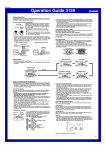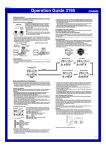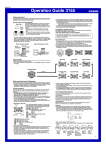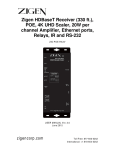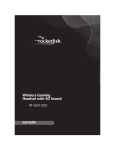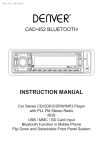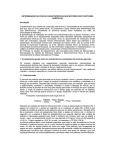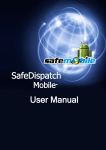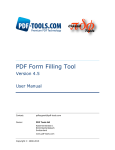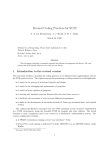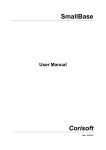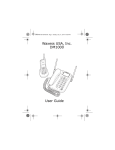Download PortAlyzer Tester Manual
Transcript
ODYSSEY® Battery Heavy Duty Diagnostic Tester User Guide IMPORTANT NOTICES SAFETY All DANGER, WARNING, IMPORTANT messages and Notes must be followed for your safety. These safety messages are in the following formats: DANGER: Means you may risk possible loss of life WARNING: Means you may risk possible bodily harm IMPORTANT: Means you risk damage to the vehicle or the tool Notes: are added to provide clarity and helpful tips These safety messages cover situations of which the manufacturer of the ODYSSEY® Heavy Duty Battery Diagnostic Tester is aware. The manufacturer cannot know, evaluate and advise you as to all of the possible hazards. You must be certain that any conditions or service procedures encountered do not jeopardize your personal safety. COPYRIGHT No part of this manual may be reproduced, stored in a retrieval system or transmitted, in any form or by any means, electronic, mechanical, photocopying, recording, or otherwise, without the prior written permission of EnerSys®. DISCLAIMER All information, illustrations and specifications contained in this technical instruction manual are based on the latest information available at the time of publication. The right is reserved to make changes at any time without obligation to notify any person or organization of such revisions or changes. Further, EnerSys® shall not be liable for errors contained herein or for incidental or consequential damages (including lost profits) in connection with the furnishing, performance or use of this material. © 2008 EnerSys. All rights reserved. ODYSSEY® BATTERY HEAVY DUTY HANDHELD BATTERY & ELECTRICAL SYSTEM TESTER USER GUIDE Contents Chapter 1: General Information . . . . . . . . . . . . . . . . . . . . . . . . . . 1 Component Identification . . . . . . . . . . . . . . . . . . . . . . . . . . . . . . . . . . . . . . . . 1 PortAlyzer™ Heavy Duty Tester . . . . . . . . . . . . . . . . . . . . . . . . . . . . . . . . 1 Test Lead with Battery Clamps . . . . . . . . . . . . . . . . . . . . . . . . . . . . . . . . . 1 Chapter 2: ODYSSEY® Battery Tests . . . . . . . . . . . . . . . . . . . . . . 3 Pretest Steps. . . . . . . . . . . . . . . . . . . . . . . . . . . . . . . . . . . . . . . . . . . . . . . . . . 3 EnerSys® Batteries and Functions . . . . . . . . . . . . . . . . . . . . . . . . . . . . . . . . . 3 Chapter 3: Non-ODYSSEY® Battery Tests . . . . . . . . . . . . . . . . . . 5 Pretest Steps. . . . . . . . . . . . . . . . . . . . . . . . . . . . . . . . . . . . . . . . . . . . . . . . . . 5 Other Batteries and Functions (non-ODYSSEY® batteries) . . . . . . . . . . . . . . 6 IN VEHICLE Battery and Electrical System Test (non-ODYSSEY® batteries) 6 OUT OF VEHICLE Battery Test . . . . . . . . . . . . . . . . . . . . . . . . . . . . . . . . . . . 9 QUICK TEST (Battery) . . . . . . . . . . . . . . . . . . . . . . . . . . . . . . . . . . . . . . . . . 10 Understanding Test Results . . . . . . . . . . . . . . . . . . . . . . . . . . . . . . . . . . . . . 11 Battery Test Results . . . . . . . . . . . . . . . . . . . . . . . . . . . . . . . . . . . . . . . . 11 System Test Results . . . . . . . . . . . . . . . . . . . . . . . . . . . . . . . . . . . . . . . . 11 Chapter 4: More Functions Menu . . . . . . . . . . . . . . . . . . . . . . . . 13 VIEW LAST TEST Results . . . . . . . . . . . . . . . . . . . . . . . . . . . . . . . . . . . . . . 13 SOFTWARE UPDATE. . . . . . . . . . . . . . . . . . . . . . . . . . . . . . . . . . . . . . . . . . 14 UNIT VERSION. . . . . . . . . . . . . . . . . . . . . . . . . . . . . . . . . . . . . . . . . . . . . . . 14 TEST COUNTERS . . . . . . . . . . . . . . . . . . . . . . . . . . . . . . . . . . . . . . . . . . . . 14 STORED TESTS. . . . . . . . . . . . . . . . . . . . . . . . . . . . . . . . . . . . . . . . . . . . . . 15 MANUAL CRANK DATA . . . . . . . . . . . . . . . . . . . . . . . . . . . . . . . . . . . . . . . . 15 ACC LOAD TEST . . . . . . . . . . . . . . . . . . . . . . . . . . . . . . . . . . . . . . . . . . . . . 16 PortAlyzer™ Battery Tester User Guide Safety Precautions Safety Precautions DANGER: • When an engine is operating, keep the service area WELL VENTILATED or attach a building exhaust removal system to the engine exhaust system. Engines produce carbon monoxide, an odorless, poisonous gas that causes slower reaction time and can lead to serious injury or death. WARNING: • Wear an American National Standards Institute (ANSI) approved eye shield when testing or repairing vehicles. Objects propelled by whirling engine components or pressurized liquids escaping may cause personal injury. • Set the parking brake and block the wheels before testing or repairing a vehicle. It is especially important to block the wheels on front-wheel drive vehicles because the parking brake does not hold the drive wheels. • Do not drive the vehicle and operate the tester at the same time. Any distractions may cause an accident. Have one person operate the tester as another person drives the vehicle. • Maintain adequate clearance around moving components or belts during testing. Moving components and belts can catch loose clothing, body parts or test equipment and cause serious damage or personal injury. • Automotive batteries contain sulfuric acid and produce explosive gases that can result in serious injury. Stand back from the battery during testing. To prevent ignition of gases, keep lighted cigarettes, sparks, flames and other ignition sources away from the battery at all times. • Do not test a frozen battery, as it may explode. Allow the battery to warm up before testing. • Do not spray liquids on the tester. Liquids may enter the tester and cause permanent damage to the electrical components. Flammable liquids may cause an explosion. • Do not use the test leads if the insulation is damaged or if metal is exposed. • Do not remove the test leads while a test is running. • Do not touch the test leads, tips or the circuit being tested. • Refer to the service manual for the vehicle being serviced and adhere to all diagnostic procedures and precautions. IMPORTANT: To prevent damage to the vehicle computer when disconnecting battery cables: • Turn the ignition and all accessories and loads off. Close the vehicle doors and trunk lid. • Remove the negative battery cable first, then remove the positive cable. i This page is intentionally blank PortAlyzer™ Battery Tester User Guide Chapter 1: General Information 1 Component Identification 1: General Information The PortAlyzer™ Heavy Duty Battery Tester is a portable, hand-held tool that tests the condition of 12 volt batteries as well as 12 or 24 volt battery packs. 1 The PortAlyzer Heavy Duty Battery Tester tests thin plate pure lead absorbed glass mat (AGM) batteries within the 50 to 4000 Cold Cranking Amp (CCA), Cranking Amp (CA), Amp Hours (A-HR), Japanese Industrial Standard (JIS) or German-Duetche Industry Norm (DIN) capacity ratings. Component Identification 2 4 3 The PortAlyzer Heavy Duty Battery Tester includes the following system components: • • • • Carrying Case User Guide PortAlyzer Heavy Duty Battery Tester Test Lead with Battery Clamps Figure 1.2: PortAlyzer™ Heavy Duty Battery Tester The front and back of the PortAlyzer Heavy Duty Battery Tester have the following components: PortAlyzer™ Heavy Duty Battery Tester 1 2 3 Item 1 Digital Display - displays four lines. Item 2 Keypad - has the following keys: • MENU - returns to the main menu screen. • Up and Down Arrows - scrolls up and down on a screen or within a data field for making selections on the screen. 4 • GO - executes a screen command and advances to the next screen or step in a procedure. • OFF - turns the PortAlyzer Heavy Duty Battery Tester off when it is not connected to a battery. Figure 1.1: PortAlyzer™ Heavy Duty Battery Tester, Top View The top of the PortAlyzer Heavy Duty Battery Tester has the following components: Item 1 RJ45 Port - connects a personal computer (PC) for updating the internal software. • ON - turns the PortAlyzer Heavy Duty Battery Tester on when it is not connected to a battery. (When properly connected to a battery, the tester turns on automatically.) Item 2 Test Lead Port - connects the battery clamp test lead. Item 3 Security Cable Connector - attaches a security cable for protecting against theft, loss or dropping. Item 3 Infrared Lights - not used. Item 4 Battery Compartment - holds one 9 volt battery. Item 4 Red and Black Jacks - not used. Test Lead with Battery Clamps 2 1 3 Figure 1.3: Test Lead with Battery Clamps Item 1 Connector - connect to the top of the PortAlyzer Heavy Duty Battery Tester. Item 2 Black Clamp - connect to the battery negative terminal. Item 3 Red Clamp - connect to the battery positive terminal. 2 This page is intentionally blank PortAlyzer™ Battery Tester User Guide Chapter 2: ODYSSEY® Battery Tests Overview 2: ODYSSEY® Battery Tests Overview The PortAlyzer™ Heavy Duty Battery Tester reports the battery condition of EnerSys® 12 or 24 volt batteries. Pretest Steps To prepare for testing, follow these steps: 1 Check the following: • WARNING: When connecting and disconnecting from the positive terminal, be careful of battery hold downs. Major arcing will occur if your positive clamp simultaneously contacts both the positive terminal and battery hold down. • If the battery being tested is frozen, let it warm up before testing. • Make sure that the terminals of the battery being tested are clean and dry; clean with a wire brush if necessary. • If the battery being tested was recently charged or used (is in a vehicle that had the engine running), let the battery stabilize 3 minutes before testing. Otherwise, let the battery stabilize 1 minute before testing. • If testing a battery installed in a vehicle, make sure the contact between the battery terminals and cables is not oxidized or loose, which causes cranking and charging problems and may falsify the test results. • If testing a battery installed in a vehicle, turn off all sources that may drain current from the battery. For example, turn the vehicle’s ignition key and all accessories and other loads off, close the doors and trunk and disconnect the under-hood light. 2 Install a 9 volt battery in the battery tester’s battery compartment. To open the compartment slide the cover toward the bottom of the battery tester. Note: Replace the internal 9 volt battery if the PortAlyzer Battery Tester does not power up with its own battery or when connected to the battery to be tested. Note: Replace the internal 9 volt battery if the PortAlyzer Battery Tester returns to the Main Menu screen during a test. 3 Connect the test lead (the one with the battery clamps) to the test lead port on the top of the tester. Finger-tighten the connector’s screws. 4 Attach the test lead’s clamps to the battery’s terminals: red to positive (+); black to negative (-). Note: The battery tester turns on automatically when properly connected to the battery. If it does not turn on, check the connections. Both clamps must make a solid contact with the terminals. 5 Begin test setup, select battery specifications entry by ENERSYS® BRAND (ODYSSEY BATTERIES) or NONENERSYS (OTHER BATS AND FUNCT). EnerSys® Batteries and Functions 1 Press the Up and Down Arrow keys to select the Battery Brand, press the GO key. SELECT BRAND: ODYSSEY GO TROLLING THUNDER OTHER BATS AND FUNCT Å 2 Select the Battery Model / Part Number, press the GO key. ODYSSEY PC310 PC535 PC545 Å GO 3 Select the Battery Test, press the GO key. BATTERY TEST BATTERY PACK TEST QUICK CCA TEST Å GO • If BATTERY TEST, follow the on-screen instructions. • If BATTERY PACK TEST, select the pack configuration (2x12-12V, 3x12-12V, 4x12-12V, 2X12-24V, 4X12-24V). Press the GO key and follow the on-screen instructions. • If QUICK CCA TEST, follow the on-screen instructions. 4 For further test instructions, • If testing IN VEHICLE, go to “IN VEHICLE Battery and Electrical System Test (non-ODYSSEY® batteries)” on page 6, • If testing OUT OF VEHICLE, go to “OUT OF VEHICLE Battery Test” on page 9, • If testing with QUICK TEST,go to “QUICK TEST (Battery)” on page 10 . 3 4 This page is intentionally blank PortAlyzer™ Battery Tester User Guide Chapter 3: Non-ODYSSEY® Battery Tests Overview 3: Non-ODYSSEY® Battery Tests Overview Pretest Steps The PortAlyzer™ Heavy Duty Battery Tester reports the battery condition of ODYSSEY® and non-ODYSSEY 6 / 12 / 24 volt batteries and the vehicle starting / charging system. The test results include the battery condition, the vehicle’s charging and starting system and diodes. To prepare for testing, follow these steps: IN VEHICLE: tests ODYSSEY 12 volt batteries or a nonODYSSEY 6, 12 or 24 volt system that is installed in a vehicle. The non-ODYSSEY test determines the battery conditions and then lets you continue with a test of the vehicle’s starting/charging system. The test results include the battery condition and the condition of the vehicle’s charging system, starting system and diodes. For instructions, refer to page 6. OUT OF VEHICLE: tests a ODYSSEY 12 volt battery or a non-ODYSSEY 6 or 12 volt battery. This test determines the battery condition and displays the results (good, bad, etc.) along with the battery’s open circuit voltage (OCV). For instructions, refer to page 9. QUICK TEST: determines the condition of a ODYSSEY 12 volt battery or a non-ODYSSEY 6, 12 or 24 volt battery or battery pack. The Quick Test displays the Open Circuit Voltage (OCV), Cold Cranking Amps (CCA), Cranking Amps (CA), Ampere Hours (A-HR), and German-Duetche Industry Norm (DIN) as applicable. For instructions, refer to page 10. More Functions: has the following options: • View Last Test - displays the results of the last test performed. • Set Time / Date - lets you set a date and time for printing on test results. • Software Update - updates the software when properly connected to a PC. • Unit Version - displays information about the software, such as name, version number, etc. • Test Counters - displays the number of tests done with the tester and lets you reset the counters to zero. • Stored Tests - stores the results for up to 13 tests for you to review later. • Manual Crank Data - displays live amps, maximum amps, live volts and minimum volts during engine cranking. • Acc. Load Test - checks the capacity of the alternator at idle with accessory loads applied. For instructions, refer to page 13. 1 Check the following: • WARNING: When connecting and disconnecting from the positive terminal, be careful of battery hold downs. Major arcing will occur if your positive clamp simultaneously contacts both the positive terminal and battery hold down. • If the battery being tested is frozen, let it warm up before testing. • Make sure that the terminals of the battery being tested are clean and dry; clean with a wire brush if necessary. • If the battery being tested was recently charged or used (is in a vehicle that had the engine running), let the battery stabilize 3 minutes before testing. Otherwise, let the battery stabilize 1 minute before testing. • If testing a battery installed in a vehicle, make sure the contact between the battery terminals and cables is not oxidized or loose, which causes cranking and charging problems and may falsify the test results. • If testing a battery installed in a vehicle, turn off all sources that may drain current from the battery. For example, turn the vehicle’s ignition key and all accessories and other loads off, close the doors and trunk, and disconnect the under-hood light. 2 Install a 9 volt battery in the battery tester’s battery compartment. (To open the compartment, slide the cover toward the bottom of the tester.) Note: Replace the internal 9 volt battery if the PortAlyzer Battery Tester does not power up with it’s own battery or when connected to the battery to be tested. Note: Replace the internal 9 volt battery if the PortAlyzer Battery Tester returns to the Main Menu screen during a test. 3 Connect the test lead (the one with the battery clamps) to the test lead port on the top of the tester. Finger-tighten the connector’s screws. 4 Attach the test lead’s clamps to the battery’s terminals: red to positive (+); black to negative (-). Note: The battery tester turns on automatically when properly connected to the battery. If it does not turn on, check the connections. Both clamps must make a solid contact with the terminals. 5 6 PortAlyzer™ Battery Tester User Guide Other Batteries and Functions (non-ODYSSEY® batteries) Other Batteries and Functions (non-ODYSSEY® batteries) Batteries that are not an ODYSSEY® battery must have the specifications entered manually. IN VEHICLE Battery and Electrical System Test (non-ODYSSEY® batteries) To enter the battery specifications manually, follow these steps: The IN VEHICLE test is a 35 second test to determine the condition of the battery and the vehicle’s starting (cranking) system, diodes and charging system. 1 Press the Up or Down Arrow keys to select OTHER BAT&FUNCTS. Press the GO key, the main menu will appear for battery test selection. To do the IN VEHICLE test, follow these steps: SELECT BRAND: ODYSSEY TROLLING THUNDER OTHER BATS AND FUNCT IN VEHICLE OUT OF VEHICLE QUICK TEST More Functions GO GO 2 Continue with the appropriate test steps (in the next three sections) for testing IN VEHICLE, OUT OF VEHICLE and QUICK TEST. 1 Do the steps in “Overview”. This displays the main menu on the tester. IN VEHICLE OUT OF VEHICLE QUICK TEST More Functions GO Warning: When connecting and disconnecting from the positive terminal, be very careful of battery hold downs. Major arcing will occur if your positive clamp simultaneously contacts both the positive terminal and battery hold down. Note: The word GO indicates the selected item. 2 Use the Up and Down Arrow keys to select IN VEHICLE and then press the GO key. This displays the Select Charging System screen. Select Charging Sys: 12 Volts 6 Volts 24 Volts GO 3 Use the Up and Down Arrow keys to select the correct charging system, then press the GO key. This displays a question about the status of the battery. Known Good Battery?: YES NO 4 Determine the status of the battery, if known: • If the battery is known to be good, press the Up Arrow key. This will skip the remaining questions about the battery(s) and take you immediately to the start of the actual test. Go to step 14. • If the status of the battery is not known, press the Down Arrow key. This displays the Number/Type of Battery screen. NUMBER/TYPE OF BATT 1X12VOLT BATT GO 2X12VOLT BATTS 3X12VOLT BATTS Note: The possible selections continue beyond the first screen. Use the Down Arrow key to view all of the possible selections. PortAlyzer™ Battery Tester User Guide Chapter 3: Non-ODYSSEY® Battery Tests ® IN VEHICLE Battery and Electrical System Test (non-ODYSSEY batteries) 5 Use the Down Arrow key to select the correct number(s) and type(s) of batteries, then press the GO key. This displays the Select Battery Type screen. Select Battery Type CONVENTIONAL AGM/GELL Change Batt. Type GO 6 Do one of the following: • If the battery is conventional (flooded lead acid), press the GO key. • If the battery is AGM or GELL, press the Down Arrow key, then press the GO key. 7 Press the GO key. This displays the Select Units screen. SELECT UNITS CCA GO CA/MCA Change A-HR DIN JIS 8 Use the Down Arrow key to select a capacity rating for the test. The GO indicates the selected line. Note: This is the battery’s capacity rating that is usually found on the battery’s label. Depending on the battery, use any of the following: • CCA - Cold Cranking Ampere rating • CA / MCA - Cranking Ampere / Marine Cranking Ampere rating • A-HR - Ampere Hours • DIN - German-Duetche Industry Norm • JIS - Japanese Industrial Standard 9 After selecting a capacity rating, press the GO key. This displays a screen for entering the capacity rating. Enter Rated CCA For One Batt. 700 GO To Change Value Note: If the battery pack you are testing is mismatched, disassemble the pack and test each battery individually. 10Use the Up and Down Arrow keys and adjust the rating until it matches the rating on the battery’s label. Note: Do not use the rating reported by the Quick Test because it is typically higher than the printed rating for a newer battery. 11 Press the GO key. This displays the battery’s Open Circuit Voltage (OCV). PRESS GO 12.57V 12Press GO. The battery pack test is performed. If the pack is good, go to step 13. Note: If the battery pack is determined to be low, the screen pictured below will be displayed and the battery tester will begin the Quick Idle test. Follow the on-screen prompts to complete the Quick Idle test. START THE ENGINE RUN AT IDLE SPEED GO = CONTINUE = NO START Note: If the engine does not start, press the Up Arrow key. The battery tester will proceed to the individual battery tests. 13Wait for the screen to display “Is this an AIR-START vehicle?” IS THIS AN AIR-START VEHICLE? YES NO 14If you are testing an air-start vehicle, press the Up Arrow key for “Yes”. If it is not an air-start vehicle, press the Down Arrow key for “No”. The “start engine” screen is displayed. START VEHICLE AND TURN OFF LOADS AC,R-DEFOG,ETC ‘GO’ IF NO START ‘MENU’ 15Start the vehicle’s engine and then press the GO key. This starts the test and displays the series of screens shown on the next page. Note: If the engine does not start, press the MENU key. This displays the battery test results as described in step 17 on page 8. Charge the battery(s) or use a booster battery to provide power. 7 8 PortAlyzer™ Battery Tester User Guide IN VEHICLE Battery and Electrical System Test (non-ODYSSEY® batteries) INCREASE IN RPM WILL BE REQUIRED PRESS GO RUN ENGINE ABOVE 1500 RPM NOW AND MAINTAIN FOR 15 SECONDS MAINTAIN SPEED VOLTS = 14.70v WITH ENGINE IDLING TURN ON ALL OF THE ELECTRICAL ACC/LOADS PRESS GO TEST COMPLETE TURN ENGINE OFF 18The second screen of test results displays charging system test results, which includes loaded and open-circuit (no load) voltages, and the test results for the charging system. Press the Down Arrow key to display the next screen, or the Up Arrow to review the previous screen(s). Note: Possible charging system results are GOOD or CHARGING SYSTEM NEEDS REPAIR. DIODES MORE OCV 12.57 TESTED CCA 1122 BATTERY GOOD MORE GO - Print Note: The test results appear on several screens. They may include special messages, readings, or condition results. To view each screen, use the Down Arrow key. The following steps are examples from a good battery and system. For test result descriptions, refer to “Understanding Test Results” on page 11. 17If the battery and system test is good, the first screen of test results displays the battery test results (shown above). These include battery condition, Open-circuit Voltage (OCV), and actual Cold Cranking Ampere rating (CCA). Press the Down Arrow key to display the next screen. Note: Other possible results for the first screen include NO START CONDITION, CHARGING VOLTS TOO LOW, BAT. GOOD/ LOW CHARGE, BAT. BAD, and BAT. CHARGE AND RETEST. CHG.LOAD V=13.73 CHG.NO LOAD V=13.74 CHG. VOLTS GOOD MORE BACK GO-Print BACK GO-Print 19The third screen of test results displays the condition of the diodes. Press the Down Arrow key to display the next screen, or the Up Arrow to review the previous screen(s). Note: Possible diode results are GOOD, BAD or NA. ACC.LOAD V=14.21 ACC. LOAD VOLTS GOOD MORE 16Follow the instructions given on the screens to hold the engine RPM above 1500 for 15 seconds and then turn the engine off. The test results display immediately. GOOD BACK GO-Print 20The fourth screen of test results displays the loaded system test results. Press the Down Arrow key to display the next screen, or the Up Arrow to review the previous screen(s). Note: Possible Acc. Load results are GOOD or LOW. CRANKING V=10.84 GOOD BACK GO-Print 21The final screen of test results displays the cranking voltage (voltage during starting) and condition. You can use the Up Arrow to review the previous screen(s), print the test results or return to the main menu using the following steps. Note: Possible cranking voltage results are GOOD or LOW. 22To end the test and return to the main menu, press the MENU key. 23Select another test or disconnect the clamps from the battery. 24Press the OFF key to turn the battery tester off. (The battery tester turns off automatically after a few minutes of inactivity.) PortAlyzer™ Battery Tester User Guide Chapter 3: Non-ODYSSEY® Battery Tests OUT OF VEHICLE Battery Test OUT OF VEHICLE Battery Test The OUT OF VEHICLE test takes about 13 seconds to determine if the battery is good, has a low charge or is bad. The test shows the battery condition even if the battery is discharged down to 1 volt state of charge. To do the OUT OF VEHICLE test, follow these steps: 1 Do the steps in “Overview”. This displays the main menu on the battery tester. IN VEHICLE OUT OF VEHICLE QUICK TEST More Functions GO Note: The word GO indicates the selected item. 2 Use the Up and Down Arrow keys to select OUT OF VEHICLE and then press the GO key. This displays the Choose Battery Type screen. Select Battery Type CONVENTIONAL AGM/GELL Change Batt. Type GO 3 Do one of the following: • If the battery is conventional (flooded lead acid), press the GO key. • If the battery is AGM, GELL or OPTIMA, press the Down Arrow key, then press the GO key. This displays the battery’s open circuit voltage (OCV). PRESS ’GO’ 12.60v Note: If the battery tester senses abnormal conditions, such as very low voltage, other screens may display. Respond to any questions as necessary. 4 Press the GO key. This displays the Select Units screen. SELECT UNITS CCA GO CA/MCA Change A-HR DIN JIS 5 Use the Down Arrow key to select a capacity rating for the test. The GO indicate the selected line. Note: This is the battery’s capacity rating that is usually found on the battery’s label. Depending on the battery, use any of the following: • CCA - Cold Cranking Ampere rating • CA / MCA - Cranking Ampere / Marine Cranking Ampere rating • A-HR - Ampere Hours • DIN - German-Duetche Industry norm • JIS - Japanese Industrial Standard This displays a screen for entering the capacity rating. Enter Rated CCA For One Batt. 700 GO To Change Value 6 Use the Up and Down Arrow keys and adjust the rating until it matches the rating on the battery’s label. Note: Do not use the rating reported by the Quick Test because it is typically higher than the printed rating for a newer battery. 7 Press the GO key to begin the load and recovery part of the test. The screen displays First Load On, Second Load On, Recovery Period and then Working as it applies two medium loads to the battery followed by recovery periods and then determines the battery condition. Note: If the battery tester senses abnormal conditions, such as a cold battery, other screens may display. Respond to any questions as necessary. 8 When the test is complete, the screen displays the battery condition, the Open Circuit Voltage (OCV) and the Cold Cranking Amps (CCA). BAT. GOOD OCV. 12.5 CCA 709 Print Results = GO Note: For some capacity ratings, the A-HR reading appears instead of the CCA reading. For the JIS capacity rating, the JIS code displays. 9 Analyze the test results. For descriptions of possible test results, refer to “Understanding Test Results” on page 11. 10To end the test and return to the main menu, press the MENU key. 11 Select another test or disconnect the clamps from the battery. Press the OFF key to turn the battery tester off. (The battery tester turns off automatically after a few minutes of inactivity.) 9 10 PortAlyzer™ Battery Tester User Guide QUICK TEST (Battery) QUICK TEST (Battery) The QUICK TEST is a 1 second test to determine the battery voltage and actual Cold Cranking Amperes (CCA), Cranking Ampere rating (CA), Ampere Hours (A-HR), and GermanDeutche Industry Norm (DIN) if applicable. To do the QUICK TEST, follow these steps: 1 Do the steps in “Overview”. This displays the main menu on the battery tester. IN VEHICLE OUT OF VEHICLE QUICK TEST More Functions GO Warning: When connecting and disconnecting from the positive terminal, be very careful of battery hold downs. Major arcing will occur if your positive clamp simultaneously contacts both the positive terminal and battery hold down. Note: The word GO indicates the selected item. 2 Use the Up and Down Arrow keys to select QUICK TEST and then press the GO key. This displays the Select Battery Type screen. Select Battery Type CONVENTIONAL AGM/GELL Change Batt. Type GO 3 Do one of the following: • If the battery is conventional (flooded lead acid), press the GO key. • If the battery is AGM or GELL, press the Down Arrow key, then press the GO key. This displays the battery’s open circuit voltage (OCV). PRESS ’GO’ 12.60v 4 Press the GO key. This displays the Select Charging System screen. SELECT CCA TYPE 12 V CCA 6 V CCA 24 V CCA GO 5 Use the Down Arrow key to select the charging system type for the test. The GO indicates the selected line. 6 Press the GO key to begin the test. The screen displays Working as determines the battery’s capacity. Note: If the battery tester senses abnormal conditions, such as a cold battery, other screens may display. Respond to any questions as necessary. 7 When the test is complete, the screen displays the open Circuit Voltage (OCV) and the Cold Cranking Amps (CCA). OCV 12.54 ↓ CCA 650 8 Repeatedly press the Down Arrow key to change the second line to Cranking Amps (CA), then Ampere Hours (AHR), German-Deutche Industry Norm (DIN), then back to Cold Cranking Amps (CCA). 9 To end the test and return to the main menu, press the MENU key. 10Select another test or disconnect the clamps from the battery. 11 Press the OFF key to turn the battery tester off. (The battery tester turns off automatically after a few minutes of inactivity.) PortAlyzer™ Battery Tester User Guide Chapter 3: Non-ODYSSEY® Battery Tests Understanding Test Results Understanding Test Results System Test Results This section includes descriptions for test results and tips for solving problems. CHARGE BATTERY AND RETEST SYSTEM: indicates the battery either has a low charge or is almost fully discharged and must be charged before the battery tester will run any tests. Battery Test Results BAT. GOOD: the battery is in good condition and can hold a charge. This also indicates that the charging system, cranking system and diode test will be unaffected by the battery condition. BAT. GOOD / LOW CHARGE: the battery is in good condition but needs charging. (The battery charge is above 15% but not close to the full nominal capacity.) BAT. CHARGE & RETEST: the battery is almost fully discharged and the battery condition cannot be determined reliably. (The battery charge is below 15% of the nominal capacity). Charge the battery and repeat the test. BAT. BAD: the battery is in bad condition and would most likely not hold enough of a charge for reliable vehicle starting. Replace the battery. Note: A bad battery can mask other charging system problems that will be caught when tested with a good battery. For example, a bad battery could make the diodes look bad. SERVICE BATTERIES AS REQUIRED AND RETEST SYSTEM: indicates battery is bad and must be replaced before the battery tester will run any tests. DIODES GOOD: indicates the rectifier diodes are good. DIODES BAD: indicates the diode pack or alternator needs replacing. Note: To prevent an erroneous diode test, the battery tester does not test diodes unless the battery condition is good. CHARGING SYSTEM GOOD: indicates the charging system is in good condition. CHARGING VOLTS TOO LOW/HIGH CHARGING SYSTEM NEEDS REPAIR: indicates the charging system voltages are too low/high. The charging system is faulty. If the no load voltage is too low, the battery test result may be GOOD/LOW CHARGE. CRANKING GOOD: indicates the starting system is in good condition. NO START CONDITION: indicates the battery is bad or needs recharging. This result may also appear if the battery is too small for the vehicle, if the starter motor is defective or if the cranking resistance is excessive. Make sure the battery size is correct and there are no starter or engine problems. 11 12 This page is intentionally blank PortAlyzer™ Battery Tester User Guide Chapter 4: More Functions Menu VIEW LAST TEST Results 4: More Functions Menu This chapter includes the following sections: • • • • • • • View Last Test Software Update VIEW LAST TEST Results The More Functions, VIEW LAST TEST function displays the test results of the last test performed. Unit Version Test Counters To view the last test results, follow these steps: Stored Tests 1 If necessary, press the ON key to turn the tester on and display the main menu. (If the tester is already on, press the MENU key to display the main menu.) Manual Crank Data Accessory Load Test IN VEHICLE OUT OF VEHICLE QUICK TEST More Functions GO Note: The word GO indicates the selected item. 2 Use the Down Arrow key to select More Functions, then press the GO key. VIEW LAST TEST SET TIME/DATE SOFTWARE UPDATE GO 3 Use the Up and Down Arrow keys to select VIEW LAST TEST and then press the GO key. This displays the test results. BAT. GOOD OCV. 12.5 CCA 709 Print Results = GO 4 If necessary, use the Down Arrow key to scroll through the test results. 5 To return to the main menu, press the MENU key. 6 Select another test or disconnect the clamps from the battery (if connected). 7 Press the OFF key to turn the tester off. (The tester turns off automatically after a few minutes of inactivity.) Note: Because the battery tester shuts off automatically after a few minutes, it may be helpful to connect the battery tester to a battery before performing the steps in this chapter. (To do this, refer to “VIEW LAST TEST Results” on page 13.) 13 14 PortAlyzer™ Battery Tester User Guide SOFTWARE UPDATE SOFTWARE UPDATE TEST COUNTERS The Software Update function allows for software updates. Instructions will be provided as updates become available. The Test Counters function displays the number of System Tests, Battery Tests and Quick Tests that have been done with the tester and lets you reset the counters to zero. UNIT VERSION The Unit Version function displays information about the software, such as name, version number, etc. To display the version information, follow these steps: 1 Press the ON key to turn the battery tester on. This displays the main menu. IN VEHICLE OUT OF VEHICLE QUICK TEST More Functions 1 Press the ON key to turn the battery tester on. This displays the main menu. IN VEHICLE OUT OF VEHICLE QUICK TEST More Functions GO Note: The word GO indicates the selected item. GO Note: The word GO indicates the selected item. 2 Repeatedly press the Down Arrow key until More Functions is selected. Then press the GO key. This displays the More Functions menu. UNIT VERSION VIEW LAST TEST SET TIME/DATE SOFTWARE UPDATE To display and reset the test counters, follow these steps: GO 3 Use the Down Arrow key to select UNIT VERSION and then press the GO key. This displays the version information. PORTALYZER HEAVY V#.### Program PN-####### release date Press GO to continue 4 Press the GO key to return to the More Functions menu. 5 Press the MENU key to return to the main menu. 2 Repeatedly press the Down Arrow key until More Functions is selected. Then press the GO key. This displays the More Functions menu. TEST COUNTERS VIEW LAST TEST SET TIME/DATE SOFTWARE UPDATE GO 3 Use the Down Arrow key to select TEST COUNTERS and then press the GO key. This displays the test counts. System Tests Battery Tests Quick Tests Press ↓ to clear ### ### ### 4 To reset all the counters to zeros (000), press the Down Arrow key. 5 When finished, press the MENU key twice to return to the main menu. PortAlyzer™ Battery Tester User Guide Chapter 4: More Functions Menu STORED TESTS STORED TESTS MANUAL CRANK DATA The Stored Tests function stores up to 13 tests and lets you review them later. The Manual Crank Data function displays data acquired during engine cranking. To view stored test results, follow these steps: To view Manual Crank Data, follow these steps: 1 Press the ON key to turn the battery tester on. This displays the main menu. 1 Press the ON key to turn the battery tester on. This displays the main menu. IN VEHICLE OUT OF VEHICLE QUICK TEST More Functions GO Note: The word GO indicates the selected item. 2 Use the Down Arrow key to select More Functions, then press the GO key. This displays the More Functions menu. VIEW LAST TEST SET TIME/DATE SOFTWARE UPDATE GO 3 Repeatedly press the Down Arrow key until STORED TESTS shows on the screen and is selected. Then press the GO key. This displays the Stored Tests screen. STORED TESTS View Stored Tests↑ Clear Stored Tests↓ Press MENU to exit 4 Do one of the following: • To view a stored test, press the Up Arrow key. This displays the View Stored Tests screen. View Stored Tests Number of tests: ## View test: ## ↑↓ GO Dated: ##/##/## ##:## This screen shows the number of stored tests, the number of the currently selected test and the date and time of the currently selected test. Use the Up (or Down) Arrow key to select the test number to view and then press the GO key. This displays the results for the selected test. Note: If the results have more than one screen, use the Down Arrow key to scroll to the next screen(s). Optionally, press the GO key to print the test results. When finished, press the MENU key to return to the main menu. • To clear the stored tests, press the Down Arrow key. This displays the Clear Stored Tests screen. Clear Stored Tests Press ↑ to clear ALL stored tests or MENU to exit. 5 To clear all the stored tests, press the Up Arrow key. The message, “ALL TESTS CLEARED” appears on the screen. Use the MENU key to return to previous screens. IN VEHICLE OUT OF VEHICLE QUICK TEST More Functions GO Note: The word GO indicates the selected item. 2 Use the Down Arrow key to select More Functions, then press the GO key. This displays the More Functions menu. VIEW LAST TEST SET TIME/DATE SOFTWARE UPDATE GO 3 Repeatedly press the Down Arrow key until MANUAL CRANK DATA shows on the screen and is selected. Then press the GO key. This displays the first Manual Crank data screen. TURN OFF ALL LOADS: LIGHTS, RADIOS, A/C, ETC. Press GO 4 Follow the on-screen instructions and turn off all loads (lights, radios, A/C, etc.), then press the GO key. This displays the manual crank data.. 13.7V CRANK 9.8V 0.07A CRANK 0.07A Clear Crank Data ↑ 5 The manual crank data includes fixed readings for maximum amps and minimum volts (the readings on the right) and live amps and live volts (displayed on the left). Use the Up Arrow key to clear the crank data. 6 Press the MENU key twice to return to the main menu. 15 16 PortAlyzer™ Battery Tester User Guide ACC LOAD TEST ACC LOAD TEST The ACC Load Test function checks the output of the alternator at idle and checks the effect of adding all accessories and electrical loads. To perform the ACC Load Test, follow these steps: 1 Press the ON key to turn the battery tester on. This displays the main menu. IN VEHICLE OUT OF VEHICLE QUICK TEST More Functions GO Note: The word GO indicates the selected item. 2 Use the Down Arrow key to select More Functions, then press the GO key. This displays the More Functions menu. ACC LOAD TEST VIEW LAST TEST SET TIME/DATE SOFTWARE UPDATE GO 3 Repeatedly press the Down Arrow key until ACC LOAD TEST shows on the screen and is selected. Then press the GO key. This displays the first ACC Load Test screen. START THE ENGINE AND LET IT IDLE FOR 20 SECONDS PRESS GO 4 Follow the on-screen instructions to start the engine and let it idle for 20 seconds, then press the GO key. This displays the next instruction in the ACC Load Test. WITH ENGINE IDLING, TURN ON ALL OF THE ELECTRICAL ACC/LOADS PRESS GO 5 Follow the on-screen instructions to turn on all of the electrical/accessory loads, then press the GO key. This performs the test. TEST COMPLETE! TURN OFF ALL OF THE ELECTRICAL ACC/LOADS AND TURN OFF ENGINE 6 Follow the on-screen instructions to turn off all of the electrical/accessory loads and turn off the engine. This displays the test results. ACC. LOAD V=13.709 ACC. LOAD VOLTS OK GO=Print Note: Possible ACC Load Test results are OK and LOW. 7 To end the test and return to the main menu, press the MENU key twice. 8 Select another test or disconnect the clamps from the battery. Press the OFF key to turn the battery tester off. (The battery tester turns off automatically after a few minutes of inactivity.) Limited Warranty THIS LIMITED WARRANTY IS EXPRESSLY LIMITED TO ORIGINAL RETAIL BUYERS OF NEW ELECTRONIC DIAGNOSTIC TOOLS (“UNITS”). • ODYSSEY® Battery PortAlyzer™ Units are warranted against defects in materials and workmanship for three years (36 months) from date of delivery. • Cables and Accessories are warranted against defects in materials and workmanship for one year (12 months) from date of delivery. This Limited Warranty does not cover and is void for any Unit that has been abused, altered, used for a purpose other than that for which it was intended or used in a manner inconsistent with instructions regarding use. The sole and exclusive remedy for any Unit found to be defective is repair or replacement, at the option of EnerSys®. In no event shall EnerSys be liable for any direct, indirect, special, incidental or consequential damages (including lost profit) whether based on warranty, contract, tort or any other legal theory. The existence of a defect shall be determined by EnerSys in accordance with procedures established by EnerSys. No one is authorized to make any statement or representation altering the terms of this Limited Warranty. DISCLAIMER THE ABOVE LIMITED WARRANTY IS IN LIEU OF ANY OTHER WARRANTY, EXPRESS OR IMPLIED AND ALL OTHER WARRANTIES, INCLUDING, BUT NOT LIMITED TO THE WARRANTY OF MERCHANTABILITY OR FITNESS FOR A PARTICULAR PURPOSE. SOFTWARE Unit software is proprietary, confidential information protected under copyright law. Users have no right in or title to Unit software other than a limited right of use revocable by SPX®. Unit software may not be transferred or disclosed without the written consent of SPX. Unit software may not be copied except in ordinary backup procedures. ORDER INFORMATION Replacement and optional parts can be ordered directly from your EnerSys authorized tool supplier. Your order should include the following information: • quantity • part number • item description Technical Service If you have any questions on the operation of the Unit, please call (800) 964-2837. Repair Service When sending a Unit for repair, please include the following information: • company name • contact name • telephone number • description of the problem • proof-of-purchase for warranty repairs • preferred method of payment for non-warranty repairs For non-warranty repairs, payment can be made with VISA®, MasterCard® or with approved credit terms. To receive a credit application, please fax your request to the Credit Department at 800-962-8734. Send the Unit to: PortAlyzerTM ODYSSEY® Battery Heavy Duty Diagnostic Tester 617 N. Ridgeview Drive Warrensburg, MO 64093 © 2008 EnerSys. All rights reserved. Trademarks and logos are the property of EnerSys and its affiliates except SPX®, VISA ®, and MasterCard®, which are not the property of EnerSys. Publication No: US-ODY-PRT-OM-001 • July 2008 Subject to revisions without prior notice. E.&O.E.
























